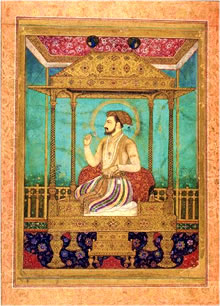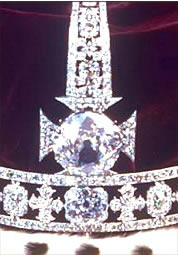|
Reviewed By Andreas Zabczyk
The Peacock Throne An Artistic Depiction of Shah Jahan on a Peacock Throne
One of the best-known UNESCO World Heritage sites is the Taj Mahal in Agra, India. It took around 20,000 people over 20 years to complete and was dedicated to Mughal Emperor Shah Jahan's beloved wife, Mumtaz Mahal, who died giving birth to their 14th child. The Taj Mahal mausoleum is constructed from white marble and the interior is inlaid with gemstones such as lapis lazuli and carnelian. This is considered by many to be one of the most beautiful buildings in the world. Yet there is a treasure that is said to have cost twice as much as the white marble mausoleum; the Peacock Throne of Shah Jahan. The Peacock Throne (also called Takht e Taus) was made in celebration of Shah Jahan's rule. It was constructed in Delhi and glittered with precious jewels which included the enormous Koh-I-Noor Diamond. The extravagant Throne contained a great deal of pure gold and precious gemstones, and took seven years to complete. The gemstones set into the Throne included pearls, emeralds, rubies, spinels, sapphires and diamonds. These jewels appeared as the multicolored feathers and other parts of a peacock surrounded by embellishments. Some of the most notable gemstones that decorated the Throne or its surround were the Akbar Shah Diamond, the Great Mughal Diamond, the Timur Ruby, the Great Table Diamond and the Shah Diamond. Ruby Cabochons and Table-Cut EmeraldAccording to Jean-Baptiste Tavernier, who had an opportunity to see the Peacock Throne when he visited the Royal Court at the Red Fort in Delhi, the Throne was set with approximately 108 large ruby cabochons, the smallest being around 100 carats in weight. These were surrounded by large table-cut emeralds which weighed around 30 to 60 carats. Altogether there were about 116 emerald gems. Tavernier's account states that suspended from the Throne were a sword, a mace, a shield and a bow, quiver and arrows. These were also set with precious gemstones, as were the cushions and steps. Tavernier observed that an eponymous gold peacock with a raised tail was above the canopy of the throne. Its tail was set with blue sapphires and other gems, and in front of its breast was a large ruby, from which hung a pear-shaped yellowish pearl, weighing approximately 50 carats. The peacock was flanked by two flower bouquets, also made from gold and precious stones. Tavernier was greatly impressed by the rows of natural pearls that decorated the columns that supported the canopy and supposed that the pearls would have contributed to a large portion of the value of the Throne. These were white, spherical and Tavernier estimated their weight to be between 6 and 10 carats each. The underside of the canopy was also decorated with diamonds and pearls, with a fringe of pearls around it. It must have been a heavenly sight for a gemstone enthusiast.  The Koh-I-Noor Diamond
The Peacock Throne was taken by Nadir Shah of Persia after his army invaded Delhi in 1739. It is not clear what happened to the throne after this, but the Koh-I-Noor Diamond was taken to Afghanistan until it was returned to India and then claimed by the British. It remains part of the British Crown Jewels, despite India wishing to have it returned. A replacement throne was constructed for the Mughal Emperor. This throne was depicted in historical Indian art and differs from Tavernier's description of the original. While it is not clear what happened to the original Peacock Throne, it inspired other thrones and splendid works of art, such as King Ludwig II's Peacock Throne in the Moorish Kiosk of Linderhof Palace, Germany. Also, the Naderi Throne of Iran features a peacock tail on the backrest. This throne is part of the Iranian Crown Jewel Collection and is displayed at the Treasury of National Jewels at the Central Bank of Iran. The Peacock Throne was not the only priceless seat of the Mughal Emperor; according to Jean-Baptiste Tavernier, there were seven bejeweled thrones in the Red Fort. It may be said that the vast riches of the Mughal Empire were of a value that is unparalleled in the modern world. Many modern rulers would be fortunate to own just a few of the fabulous jewels that decorated Shah Jahan's splendid seat of power. |
| STAY IN TOUCH | NEWSLETTER |
| *You're signing up to receive GemSelect promotional email. |
Copyright © 2005-2024 GemSelect.com all rights reserved.
Reproduction (text or graphics) without the express written consent of GemSelect.com (SETT Company Ltd.) is strictly prohibited.
2624